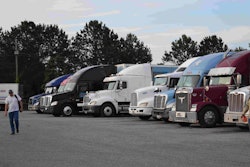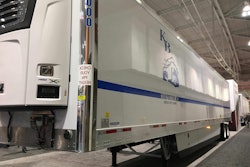 John Graham, chief executive of Omnitracs, at the Omnitracs Outlook user conference, Feb. 27.
John Graham, chief executive of Omnitracs, at the Omnitracs Outlook user conference, Feb. 27.On Tuesday, Feb. 28, a C-level team of Omnitracs executives hosted trucking media and industry analysts to a private luncheon in the Sheraton Grand Phoenix.
As guests sampled the calamari and soft pretzel appetizers, John Graham, Omnitracs’ chief executive officer, reviewed the first three years of ownership by Vista Equity Partners and discussed the company’s future in the transportation industry.
Vista acquired Omnitracs as a business unit of Qualcomm in November, 2013, for $800 million. For the first two years, Omnitracs had allocated 70 percent of its research and development (R&D) budget to sustain the products and customers it acquired, he said.
The other 30 percent was spent on new software code.
That ratio has been flipped. Now 70 percent of R&D is being invested in developing new code with nearly half of the company’s 1,200 employees being engineers, developers and IT staff.
During the next two to three years, Omnitracs plans to maintain its staffing level and capitalize on growth opportunities.
“It’s an exciting time to be in trucking and transportation,” he said.
Big opportunities
During the 2017 Omnitracs Outlook conference, company executives discussed new products and integrations that will enable it to better serve a wider range of customers and prospects that have local, regional, long haul and final-mile operations.
Kevin Haugh, chief strategy and product officer, addressed a room of fleet executives and managers on Tuesday morning. The transportation industry is going through a “massive amount of change,” he said.
 Kevin Haugh, chief strategy and product officer, discusses the future roadmap for Omnitracs on Tues., Feb. 28
Kevin Haugh, chief strategy and product officer, discusses the future roadmap for Omnitracs on Tues., Feb. 28“How are we going to capitalize on that change and be a big part of that change going forward?”
He spoke of the alignment between Omnitracs products and macro-level trends like the Internet of Things (IoT), social media, cognitive applications, and faster delivery of goods with new levels of customer service that “make it easy to click and happen.”
Converging products
One recent opportunity for Omnitracs is the electronic logging device (ELD) mandate. Graham noted that its ELD product subscriptions grew 100 percent in Feb., 2017, compared to monthly sales in Feb., 2016.
One of Omnitracs ongoing strategies is to converge its fleet mobility platforms that include the MCP 50, 100, 200 and XRS to a single platform.
The convergence took a big step forward last year when Omnitracs introduced its most powerful mobile platform to date, the Intelligent Vehicle Gateway (IVG).
The IVG uses a Windows operating system but the company has begun testing an Android version to be released at a later date.
The Android version will first incorporate the XRS platform and will later allow fleets to port their Windows-based applications to Android and run HTML 5 apps on a web browser. To make the conversion, fleets can re-flash their IVG devices to Android using a USB drive, said Jeff Champa, vice president of product management.
Omnitracs will have a new Mobile App suite with a number of driver productivity and workflow apps for document scanning, cargo claims and more. Some apps will capture data and have features that drivers can own and take with them as they change jobs. Examples include navigation preferences and the last 8 days of hours-of-service data, Champa said.
Drivers will have their own Omnitracs account and be able to associate that account, with their data and apps, to their fleet accounts.
On the driver front, Omnitracs is also creating new driver scorecards and active coaching tools that marry its business intelligence, predictive analytics, mobility and new social technologies.
 Omnitracs is exploring the use of driver wearable devices to help alert drivers to instances of fatigue.
Omnitracs is exploring the use of driver wearable devices to help alert drivers to instances of fatigue.“We will measure and coach drivers in way they have never been coached before,” he said.
Omnitracs is also exploring wearable technology to monitor driver fatigue and other safety and performance attributes. Wearable technology “hasn’t caught on fire yet, but it will,” he said. “It is an important area we need to look at.”
Optimal routing
Routing and navigation has become a centerpiece of Omnitracs’ strategy. Haugh described how the company’s Roadnet routing and scheduling optimization software will enable fleets to plan deliveries using new types of vehicles such as drones and robots among other automated delivery models.
The software is already being used by online grocer and delivery company, FreshDirect, to route vehicles to street addresses and then to route people in three dimensional spaces to make deliveries inside and outside of buildings in the most efficient way possible, he said.
At the show, Omnitracs announced a new product called Route, Dispatch, Compliance (RDC) for fleets with last-mile delivery operations that operate under hours-of-service rules. RDC creates a unified experience for the driver and gives fleets the ability to have real-time, dynamic route optimization based on the parameters of cost, time and service windows as well as live hours-of-service information, Haugh said.
As part of the routing equation, Haugh discussed new Navigation product features that take guidance to a new level for local delivery operations. The Navigation application can be configured to give drivers instructions for each customer delivery such as where to put shipments and parcels.
Platooning
One of the highlights of the conference was a new partnership between Omnitracs and Peloton to expand the possibilities of truck platooning on the nation’s highways.
 Joshua Switkes, founder and CEO of Peloton Technology, says the partnership with Omnitracs will help to expand the opportunities for inter-fleet platooning.
Joshua Switkes, founder and CEO of Peloton Technology, says the partnership with Omnitracs will help to expand the opportunities for inter-fleet platooning.Joshua Switkes, founder and CEO of Peloton Technology, said that platooning technology starts with active safety systems such as those from Bendix and Wabco that enable adaptive cruise and collision mitigation.
The Peloton system creates a direct communication link between trucks using Dedicated Short Range Communication (DSRC). The front truck tells the rear truck its engine torque, speed and other parameters. With this communication, the distance for driver perception and reaction is virtually eliminated, he said.
The system can instantaneously send a signal for a brake application from the front to the rear truck. When the front truck applies its brakes, the rear truck reacts almost simultaneously.
Platooning allows trucks to be 30 to 50 feet apart and create aerodynamics that reduce fuel consumption by 10 percent for the rear vehicle and 4.5 percent for the front truck.
Peloton’s platooning platform includes a cloud-based network operations center. This network is constantly monitoring for platooning opportunities that meet the right conditions for time, location, road restrictions, weather, traffic, and many more factors.
The system will dynamically set the front-rear pairings and the following distance based on the characteristics of each platooning event, he said.
The partnership with Omnitracs will leverage the integrated dispatch, tracking and routing applications of Omnitracs as well as its driver-facing applications to enable inter and intra-fleet platooning opportunities to a greater degree.
“That is where the synergy gets exciting with Omnitracs,” Switkes said.
Tom Benusa, chief information officer of Transport America, an Eagan, Minn.-based dry van carrier that operates more than 1,400 trucks, believes the partnership between Omnitracs and Peloton will lead to greater adoption of platooning technology.
“It will enhance the prospects for platooning to be successful,” he said. “There is not enough density in our own fleet to do platooning. Cross-fleet platooning enhances the chance for success.”











